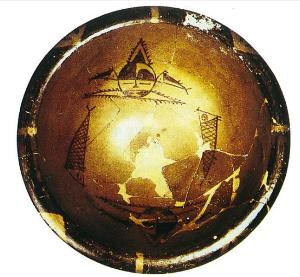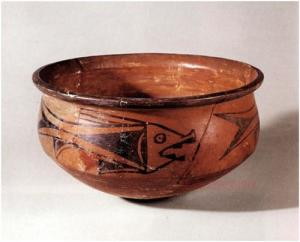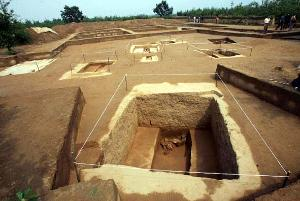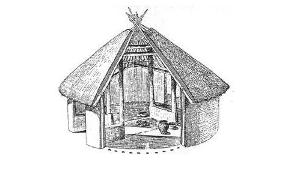Overview
The Yangshao Culture, dating from about 5000 B.C. to 3000 B.C., is a culture belonging to the Neolithic category. It was distributed throughout the middle reaches of the Yellow River from today’s Gansu Province to Henan Province, centered in the Weishui River valley and extending eastward from Baoji City, Shaanxi Province to Henan Province. The tools of production are mainly developed ground stone tools, commonly knives, axes, adzes, chisels, arrowheads, stone spinning wheels for weaving, etc. Bone tools are also quite exquisite. Various kinds of water vessels, retorts, stoves and other daily pottery are mainly mud red pottery and sandwich red and brown pottery, which are mainly red in color, and the red pottery is often painted with geometric patterns or animal patterns, which is the most obvious feature of Yangshao culture, so it is also called color pottery culture.
Cultural characteristics
Yangshao culture is an important culture of the Neolithic period in the middle reaches of the Yellow River. It lasted from about 5,000 BC to 3,000 BC. It was distributed throughout the middle reaches of the Yellow River from present-day Gansu Province to Henan Province. Today thousands of Yangshao culture sites have been discovered in China, with Henan Province and Shaanxi Province being the most numerous and the center of the Yangshao culture. The Yangshao culture derives its name from its first excavation site, Yangshao Village in Mianchi County, Sanmenxia City, Henan Province.
The Yangshao culture was a predominantly agricultural culture, and its villages were either large or small, with the larger villages having a certain layout of houses, a surrounding ditch, and cemeteries and kilns outside the village. The houses in the villages are mainly round or square, with the early houses having more round single rooms and the later ones having more square multiple rooms. The walls of the houses are made of mud, with grasses mixed in them, and also with wood as the skeleton. The exterior of the walls were mostly wrapped with grass and then burned.
The stone tools of Yangshao culture include stone axes, stone shovels, grinding wheels, etc. Besides, there are also bone tools. In addition to farming, people of the Yangshao culture apparently also engaged in fishing and hunting. Among the excavated artifacts are bone fish hooks, harpoons, arrowheads, etc. The pottery of the early Yangshao culture was mostly handmade, and the wheel-made ones began to appear in the middle period to strengthen its sturdiness and water resistance.

Yangshao culture artifacts
The excavation of the Yangshao culture cemetery has brought many contributions to the understanding of it. The burial objects and the way of burial in the cemetery bring many insights into the lifestyle, beliefs, and living conditions of the time. Some of the pottery vessels have patterns of cloth and woven fabric printed on them, thus showing that the Yangshao culture had a handicraft industry of weaving and fabric weaving. Among the excavated animal bones there are a large number of dog and pig bone frames in addition to hunted wild animals, and fewer sheep.
The internal classification of the Yangshao culture, its chronological classification, and the interrelationship between the various sites are still debated in academic circles. There are also different views on the social structure of the Yangshao culture. Most scholars today believe that it was primarily a patrilineal society, and the argument for an early matrilineal society is now supported by relatively few people. The Yangshao culture shows the social structure and cultural achievements of the Chinese matrilineal clan system from its prosperity to its decline.
At that time Antesen of Sweden, who was involved in excavating the Yangshao culture site in Yangshao Village, Sanmenxia County, Henan Province, once argued that the Yangshao culture came from the West, but he later rejected it himself. The Yangshao culture in Shaanxi is now generally considered to have developed after the Laoguantai culture, and can be divided into three different stages of development in chronological order: the Hanpo type, the Miaodi type, and the Late Hanpo type. The Longshan culture of Henan is seen as its successor culture.
Discovery process
In June 1916, when Professor Anteson, a Swede, was exploring copper resources in Shanxi, he discovered a batch of Paleocene fossils by chance, and this discovery combined with the unsustainable situation of mineral resources exploration at that time, Professor Anteson and Mr. Ding Wenjiang, the director of the Institute of Geography and Mapping at that time, then adjusted the focus of their work and switched to the large-scale collection of Paleocene fossils.
Yangshao culture is mainly distributed in the middle and lower reaches of the Yellow River, centered on a narrow strip of western Henan, the Weihe River basin in Shaanxi and southwest Shanxi, east to central Hebei, south to the middle and upper reaches of the Han River, west to the Taohe River basin in Gansu and north to the Loop area in Inner Mongolia. Nearly one hundred cultural sites have been excavated, and the excavated artifacts all reflect the more homogeneous cultural characteristics.

Yangshao Cultural Relics
The Yangshao culture site covers a total area of nearly 300,000 square meters, with cultural layers about 2 m thick and up to 4 m. In 1951, the Institute of Archaeology of the Chinese Academy of Sciences conducted a small-scale excavation of the site and found that four cultural layers were superimposed here, from bottom to top: Middle Yangshao culture – Late Yangshao culture – Early Longshan culture – Middle Longshan culture. In March 1961, the State Council designated the Yangshao culture site as a national key cultural relic protection unit. In 1994, the Chinese Museum of History organized an international field expedition of archaeologists from China and other countries, such as the United States, Britain and Japan, and found a large number of valuable cultural relics in the Ban Village near Yangshao Village, the most valuable of which is dozens of pounds of 5,000-year-old millet, indicating that China has a long history of agricultural development.
Existing sites
The Yangshao Cultural Site is located in Yangshao Village, Mianchi County, Sanmenxia City, Henan Province, 9 kilometers from the county. The site is surrounded by water on three sides, with pleasant scenery, beautiful landscapes, and fertile land, making it an ideal place for our ancestors to hunt, fish, and settle. The site is more than 900 meters long from northeast to southwest and more than 300 meters wide from northwest to southeast, with a total area of about 300,000 square meters. The thickness of the cultural layer is 2-4 meters, a phenomenon that indicates that our ancestors lived a sedentary life here for a long time.
After the discovery of the Yangshao Village site, it attracted great attention from the archaeological community, and in order to further understand the cultural connotations, ins and outs of the site, excavation and research work on the site was carried out twice more after the founding of New China.

Yangshao relics
In June 1951, Xia Nai and other experts and scholars from the Henan Survey Mission of the Institute of Archaeology of the Chinese Academy of Sciences conducted the first excavation of the Yangshao Village site in Mianchi County, Sanmenxia City, Henan Province, and found pottery jars, bowls, and small-mouthed pointed-bottom vases with black and deep red colors on a red background, as well as polished black pottery, embossed chevron gray pottery, pottery cups with streams, and rope pattern gray pottery lizards from the Longshan period. The first excavation was carried out in October-November 1980 and March-April 1981 by the Henan Provincial Institute of Cultural Relics and the Mianchi County Cultural Center, which further clarified the connotation of the ancient cultural site of Yangshao Village and confirmed that the site contains the stratigraphic superposition of two archaeological cultures, Yangshao and Longshan, and four different stages of development. The relationship between The first phase of culture belongs to the Miaodigou type of the Yangshao culture; the second phase of culture belongs to the late remains of the Yangshao culture in western Henan, southern Jin and eastern Guanzhong; the third phase of culture belongs to the Miaodigou type of the Longshan culture in Henan; and the fourth phase of culture is the Sanliqiao type of the Longshan culture in Henan. After the second excavation after the founding of New China, the Yangshao Village site has obtained a large number of relics and relics, thus providing rich physical data for the study of China’s social development history.
Yangshao culture is one of the most influential primitive cultures in the Yellow River basin, spanning 2,000 miles and stretching over thousands of years, and it is also second to none in the world. The predecessor of the Han Chinese, the “Huaxia”, first started in the Yellow River Basin, and many archaeological findings in the Yangshao culture sites, such as pottery manufacturing, weaving and clothing, painting and sculpture, writing, calendars, palace construction, etc., with the documentary record of Yan Diof the Huangdi era coincides with the inventions of the Yellow Emperor.
Production technology
Production tools are mainly developed grinding stone tools, common knives, axes, adzes, chisels, arrowheads, stone spinning wheel for textile, etc.. Bone tools are also quite exquisite. There was a relatively developed agriculture, with corn and millet as crops. The main livestock raised were pigs and dogs. Also engaged in hunting, fishing and gathering. A variety of water vessels, retorts, stoves, tripods, bowls, cups, pots, jars, urns and other daily pottery to fine clay red pottery and sandwich red brown pottery, mainly red, mostly hand-made method, with clay strips into the shape of the vessel, and then the wall of the vessel will be shot flat manufacturing. Red pottery often has painted geometric patterns or animal-shaped patterns, is the most obvious features of Yangshao culture, so also known as color pottery culture.
Yangshao culture pottery industry is developed, better mastered the selection of clay, modeling, decoration and other processes. Most of the pottery is shaped by using the clay bar tray building method, and the mouth is trimmed with a slow wheel, and various fine decorations are decorated on the surface of the vessel. Pottery types include bowls, pots, bowls, thin-necked pots, small-mouthed bottles with pointed bottoms, jars and rough pottery urns. The colorful pottery is beautifully shaped, and the surface is painted with colorful geometric patterns and animal patterns in red or black colors, among which the human face pattern, fish pattern, deer pattern, frog pattern and bird pattern are realistic and vivid. Many of the excavated pottery are artistic treasures, such as waterfowl pecking fish pattern boat-shaped pots, human face pattern pottery, fish and frog pattern pottery, stork holding fish pattern pottery, etc. The pottery sculpture artwork is also very wonderful, there are various animal statues attached to the pottery, such as falcon-shaped decoration, sheep head button, bird-shaped cover handle, human face head, gecko and eagle, etc., all of which are vivid and lifelike. On the black broadband pattern on the mouth of the pottery bowl in Half Slope and other places, more than 50 kinds of engraved symbols were found, which may have the nature of primitive writing. In Puyang Xishuipo, a dragon and tiger pattern made of mussel shells was found, which is the most complete image of dragon and tiger in primitive times known in China so far.

Fancy Pottery
China’s Yangshao culture is about five or six thousand years ago, when the pottery is mainly red pottery, gray pottery, black pottery next. Red pottery is divided into two kinds of fine clay red pottery and sandwich red pottery. The main raw material is clay, some also mixed with a small amount of sand. In the Yangshao pottery, fine clay pottery has a unique shape, the surface is red, the table is polished, there are beautiful patterns, is the most famous at that time. The fine clay pottery reflects the level of pottery making technology at that time and has certain representativeness, so the Yangshao culture is often referred to as colorful pottery culture in archaeology. The painted pottery plate excavated in Hanpo Village of Xi’an is also a product of Yangshao culture.
At that time, the production of painted pottery, according to analysis, mainly through four procedures. First, it often used red clay, sedimentary clay, black clay, etc., which has good plasticity and workability, and became a pure and fine raw material after panning and sinking and filtering. From the analysis of the unearthed colored pottery pieces, the clay quality is not inferior to the later top quality pottery. Second, making billet. Most of the color pottery bad initially is hand-made. Small vessels are directly pinched and molded; larger pottery, its body bad, generally using the clay pan building method made in two sections. Rough bad made and then put on the neck mouth, embedded in the handle, billet making process is initially completed. Its shape is round and regular, symmetry is very strong, in the wall outside the existence of the wheel pattern. This indicates that the Yangshao culture period, has begun to appear slow wheel pottery. Third, painting and decoration. Some of the finer painted pottery, before painting, often put the pottery bad into the extremely fine mud, so that it is clothed in a layer of uniform pottery coat to facilitate the painting. The color painting is the colored natural minerals painted on the pottery bad. Yangshao culture period pottery decoration is mostly with the pattern of the wooden printing board pat printed on. Fourth, kiln firing. From the archaeological excavation materials, the Yangshao culture period pottery kiln is mainly vertical cave kiln and horizontal cave kiln. They are composed of fire mouth, fire chamber, fire channel, kiln room, etc. The flame burning up in the fire chamber, through the fire channel to the kiln room. These two kinds of kilns, because of the kiln room, pottery is not directly on the flame grill, has been a great improvement over the original campfire type or stove type. Analyzing the sintering condition of the excavated pottery pieces, the firing temperature of colored pottery has reached about 950℃.
Architectural features
The Yangshao culture was an agriculture-based culture, and its villages were either large or small. The houses of the larger villages had a certain layout, surrounded by a perimeter ditch, with cemeteries and kilns outside the villages. The houses in the villages are mainly round or square, with the early houses having more round single rooms and the later ones having more square multiple rooms. The walls of the houses are made of mud, with grasses mixed in them, and also with wood as the skeleton. The exterior of the walls were mostly wrapped with grass and then burned to strengthen their sturdiness and water resistance. The site is generally on the terraces formed by long-term erosion on both sides of the river, or on a high and flat place at the confluence of two rivers, where the land is fertile and conducive to agriculture and animal husbandry, and where water and transportation are convenient.

Houses
The layout of the settlement buildings is neat and orderly. The half-slope settlement is relatively well preserved, with the living area in the center, a large trench around the outside for a week, a burial area in the north outside the trench, and a kiln site in the east. The remains of more than 40 houses were uncovered, with one large house as a place for public activities and dozens of other small and medium-sized houses facing the large house, forming a half-moon layout. The residents of Yangshao culture were buried according to certain burial customs after their death, mostly rectangular barrow tombs with pottery and other burial goods in the tombs, and children were buried in urn coffins. The straight-limb burial of a single person on his back is prevalent, but joint burial tombs account for a certain proportion. The number of people buried together varies, as many as 80 people. The burial system of women’s thick burial and mother-child joint burial reflects the characteristics of women-centered. The unified layout of the colony houses facing the central square indicates the deep-rooted blood ties that sustained clan unity at that time. These are consistent with the characteristics of matrilineal clan social organization.
Significance of the discovery
First, the excavation of the Yangshao village site was the beginning of Neolithic archaeology and modern field archaeology in China.
Before the excavation of the Yangshao site in 1921, we had no definite evidence of Neolithic remains in China, and some foreign scholars or missionaries used to preach that China had no prehistoric culture of its own, no Stone Age of its own, and that later Chinese culture and even human races were spread from the West. The discovery and excavation of the Yangshao culture site not only shows that China has a very developed Neolithic culture with its own characteristics and is an important part of the Neolithic culture in the world, but also makes those theories that claim that China has no Stone Age break down.
Second, the discovery and study of the Yangshao culture provided important clues and basic conditions for exploring the origins of Chinese civilization.
It was only after the discovery of the Yangshao culture site that field archaeological excavations in China were gradually carried out and expanded from the study of the Neolithic to the Paleolithic, Bronze Age and Iron Age, gradually establishing the Chinese archaeological system. It has made the study of Chinese archaeology an important discipline among many others. The archaeological excavations and studies of the Neolithic period have laid the foundation for exploring the origins of Chinese civilization and the study of the Xia and Shang cultures.
Third, the excavation and study of the Yangshao culture sites have become an important basis for the study of prehistoric society, proving with irrefutable facts the longevity of Chinese civilization.